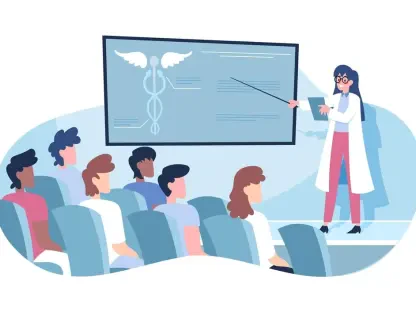In an era where digital transformation shapes every facet of healthcare, a single cyberattack can jeopardize the trust and safety of countless individuals by exposing their most sensitive information, leaving them vulnerable to identity theft and fraud. Imagine a scenario where personal health records, financial details, and identifying data are laid bare to malicious actors. This is precisely the challenge faced by Emergency Responders Health Center (ERHC), a specialized medical provider for first responders, following a significant data breach detected earlier this year. This report delves into the specifics of the incident, explores the broader landscape of healthcare data security, and examines the implications for both providers and patients in a rapidly evolving digital age.
Overview of Healthcare Data Security in the Digital Age
The healthcare industry stands as a critical pillar of society, entrusted with safeguarding some of the most personal and sensitive information about individuals. Data security in this sector is not merely a technical concern but a fundamental ethical obligation, as breaches can lead to devastating consequences such as compromised patient care and eroded public trust. With the increasing digitization of medical records, protecting this information from cyber threats has become paramount, ensuring that patient privacy remains intact amidst a landscape of evolving risks.
At present, cybersecurity in healthcare involves a complex ecosystem of stakeholders, including medical providers, technology firms, and regulatory bodies. Innovations like cloud storage and advanced encryption play a pivotal role in securing data, while regulations such as the Health Insurance Portability and Accountability Act (HIPAA) set stringent standards for compliance. However, despite these measures, the industry grapples with persistent vulnerabilities, often exploited by sophisticated cybercriminals targeting outdated systems or human error.
The stakes are high, as healthcare organizations manage vast amounts of personally identifiable information (PII) and protected health information (PHI). Key players are investing heavily in emerging technologies to bolster defenses, yet the rapid pace of digital adoption often outstrips the implementation of robust security frameworks. This dynamic underscores the urgent need for continuous improvement in cybersecurity strategies to match the growing complexity of threats.
Details of the ERHC Data Breach Incident
Timeline and Discovery of the Breach
On April 11 of this year, Emergency Responders Health Center detected suspicious activity within its email network, marking the beginning of a significant cybersecurity crisis. A subsequent investigation revealed that unauthorized access to several email accounts had occurred over a four-month period, starting from December 11 of the previous year. This prolonged exposure window highlights the stealth and persistence of the attack, which went undetected for an extended duration.
The breach compromised a wide array of sensitive data, encompassing both PII and PHI. Exposed information included patients’ names, addresses, dates of birth, Social Security numbers, driver’s license copies, health insurance details, medical records, and payment information. Such a comprehensive leak poses severe risks, as this data can be exploited for various malicious purposes, amplifying the urgency of the situation.
Notification efforts followed the completion of the investigation on September 16, with ERHC beginning to inform affected individuals via mail on September 26. Additionally, a public notice of the data security incident was published on the organization’s website on July 23. This timeline reflects the complexity of identifying and addressing the full scope of such an incident, emphasizing the challenges in rapid response and communication.
Scope and Impact of the Compromised Data
While the exact number of affected individuals remains undisclosed, the breach is believed to have impacted both current and former patients of ERHC. The lack of specific figures complicates the assessment of the incident’s scale, but the nature of the exposed data suggests a potentially widespread effect. This uncertainty adds to the anxiety among those who may have had their information compromised.
The implications of this breach are far-reaching, with risks including identity theft, financial fraud, and unauthorized access to medical services. Social Security numbers and payment details, in particular, are highly valuable to cybercriminals, who may use them to open fraudulent accounts or sell them on illicit markets. Patients face not only immediate threats but also long-term challenges in restoring their security.
Looking ahead, the fallout from this incident could influence trust in healthcare providers, as individuals question the safety of sharing personal information. The potential for reputational damage to ERHC is significant, alongside the financial burden of addressing the breach and supporting affected parties. This situation serves as a stark reminder of the real-world consequences tied to digital vulnerabilities.
Challenges in Securing Healthcare Data
Healthcare data security faces an uphill battle against increasingly sophisticated cyberattacks, which often target weak points such as email systems or unpatched software. These threats exploit both technological gaps and human factors, with phishing schemes and social engineering tactics frequently bypassing even well-designed defenses. The dynamic nature of cybercrime demands constant vigilance and adaptation from providers.
Beyond the technical challenges, resource constraints often hinder comprehensive security measures, particularly for smaller organizations like ERHC. Implementing robust cybersecurity protocols requires significant investment, which must be balanced against other operational priorities. Employee training also emerges as a critical area, as human error remains a leading cause of data breaches in the sector.
Potential solutions lie in adopting advanced threat detection systems, enhancing encryption practices, and fostering a culture of cybersecurity awareness. Collaboration between healthcare providers and technology experts can drive innovation in protective measures, while regular audits and updates to security infrastructure help mitigate risks. Addressing these challenges is essential to prevent future incidents and safeguard patient trust.
ERHC’s Response and Regulatory Compliance
In response to the breach, ERHC acted swiftly to secure the compromised email accounts and prevent further unauthorized access. A cybersecurity firm was engaged to conduct a thorough investigation, ensuring that the scope of the incident was fully understood and addressed. These initial steps reflect a commitment to containing the damage and restoring system integrity.
To support affected individuals, ERHC has offered 12 months of free credit monitoring and identity restoration services through HaystackID. Additionally, a dedicated assistance line was established for those with questions, operating weekdays from 8:00 a.m. to 8:00 p.m. Eastern Time. Such measures aim to mitigate the immediate risks faced by patients and demonstrate accountability in the wake of the incident.
From a regulatory perspective, ERHC complied with state and federal disclosure requirements by reporting the breach to the Montana Attorney General’s office on September 26. Adherence to HIPAA guidelines further underscores the organization’s efforts to align with legal standards. These actions highlight the importance of transparency and regulatory compliance in managing the aftermath of a data breach, setting a precedent for responsible handling of such crises.
Future of Data Protection in Healthcare
As cyber threats continue to evolve, the healthcare industry is turning toward cutting-edge solutions like AI-driven threat detection to stay ahead of malicious actors. These technologies can analyze patterns and identify anomalies in real-time, offering a proactive approach to security. Stronger encryption methods are also gaining traction, ensuring that even intercepted data remains unreadable to unauthorized parties.
Increased focus on patient data privacy is shaping both policy and practice, with calls for stricter regulations to enforce accountability among providers. Potential disruptors, such as ransomware and insider threats, necessitate ongoing vigilance and adaptation. The regulatory landscape is likely to tighten over the next few years, pushing organizations to prioritize security investments from this year through at least 2027.
Consumer awareness plays a pivotal role in driving demand for enhanced protection, as patients become more informed about the risks of data exposure. This trend encourages healthcare entities to adopt transparent practices and communicate effectively about their security measures. The convergence of technology, regulation, and public expectation will define the trajectory of data protection in the coming years.
Key Takeaways and Protective Measures
The ERHC data breach stands as a sobering example of the vulnerabilities inherent in healthcare cybersecurity, revealing how even specialized providers can fall victim to sophisticated attacks. The exposure of sensitive patient information, from Social Security numbers to medical records, underscores the critical need for robust defenses in an industry where trust is paramount. This incident highlights the broader challenges of securing digital systems against relentless cyber threats.
For affected individuals, proactive steps are essential to minimize potential harm. Enrolling in the free credit monitoring services offered by ERHC provides a starting point, while regularly checking credit reports and financial accounts for unusual activity adds a layer of protection. Remaining vigilant for phishing attempts and considering fraud alerts or credit freezes with major bureaus can further safeguard personal information.
Broader recommendations include leveraging tools like Identity Defender for continuous monitoring of dark-web markets and credit activity. Such services offer an early-warning mechanism to detect misuse swiftly and limit further exposure. As the healthcare sector navigates an increasingly complex threat landscape, both providers and patients must prioritize security measures to prevent and mitigate the impact of future breaches.
Reflecting on the events surrounding the ERHC incident, it became evident that the healthcare industry had to confront significant gaps in data protection with urgency. The breach exposed critical weaknesses that demanded immediate attention and long-term strategies. Moving forward, stakeholders need to commit to actionable solutions, such as enhanced cybersecurity frameworks and collaborative efforts between providers and technology experts, to rebuild trust. Investing in innovative tools and stricter compliance measures is seen as a necessary step to fortify defenses. Ultimately, the path ahead requires a collective focus on evolving threats, ensuring that patient safety remains at the forefront of digital transformation efforts.









